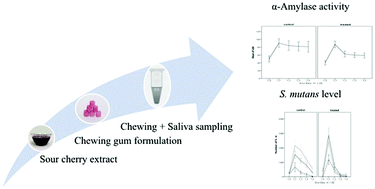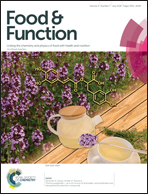Sour cherry extract inhibits human salivary α-amylase and growth of Streptococcus mutans (a pilot clinical study)†
Abstract
The purpose of this study was to determine whether cherry extract has any effect on salivary α-amylase activity (sAA) or on the level of Streptococcus mutans in human saliva. 70 patients (45 females and 25 males) in three age groups (22 children, 25 young adults, and 23 adults) were examined. All participants completed a questionnaire to obtain information on their oral health behaviour and life style. Clinical examination was performed to record the number of decayed, missing and filled teeth (DMF-T). Saliva samples were collected for the measurement of sAA and the salivary S. mutans level before and after chewing a gum with or without cherry extract. Statistical evaluation of data was performed. S. mutans and the sAA level of unstimulated saliva samples did not depend on either age or gender. The basal sAA value of adult patients was in linear correlation with the dental caries status. Habitual chewing-gum use decreased the resting sAA and the mean of DMF-T. The number of S. mutans cells was significantly lower in the resting saliva of allergic patients. The applied mechanical and gustatory stimuli by chewing gum resulted in higher sAA and S. mutans levels and a slow decrease of values was observed in the control group for the next 30 min. Thereafter, sAA and S. mutans levels decreased earlier in the presence of sour cherry extract than those of control cases. Chewing gum with sour cherry extract may be useful for the prevention of dental caries.



 Please wait while we load your content...
Please wait while we load your content...